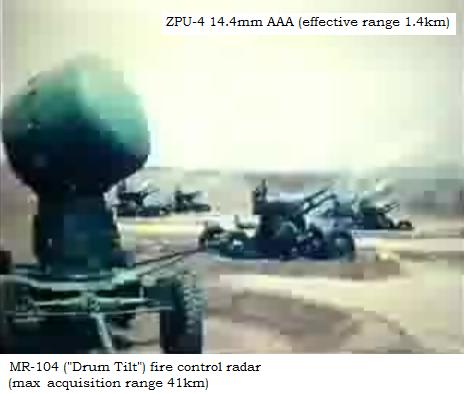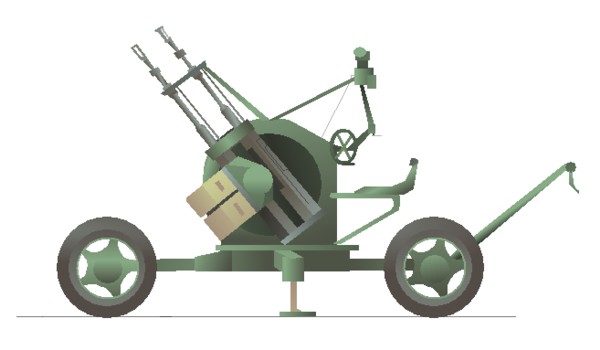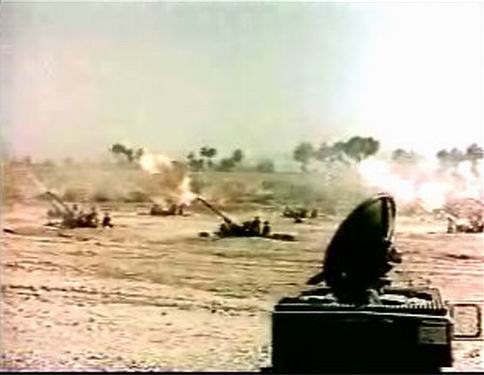It looks like you're using an Ad Blocker.
Please white-list or disable AboveTopSecret.com in your ad-blocking tool.
Thank you.
Some features of ATS will be disabled while you continue to use an ad-blocker.
share:
reply to post by Zaphod58
That's why I really hope we use a variety of drones over NK vs. manned, non-stealth aircraft.
That's why I really hope we use a variety of drones over NK vs. manned, non-stealth aircraft.
I heard about this on the radio while I was driving. It seems that NK convened a military council sometimes after midnight and put their missiles on
alert. I thought they were already on alert, so apparently I am wrong on something here. What seems strange to me is that NK was being pretty
aggressive initially, while the US and SK were not really doing anything. And now that the US and SK are conducting heavier drills and simulations, NK
wants to act like they are simply responding to the aggression.
First of all, military drills, as long as they are conducted in another country, are of no concern to NK. While they may be a deterrent in some instances, they definitely are not aggressive actions. They are simply preparations. The military conducts various drills all the time. Actually, the closest we ever came to nuclear war, besides the Cuban Missile Crisis, was with Russia because of a US simulation. The worst part is that Russia already knew the US was conducting the drill, because it was annual. Anyway, I just think that even without drills by the US and SK, NK will find something to complain about and threaten over.
I am usually an advocate against war, but I think that sooner or later it may become necessary to get involved in a war with NK, which will not end well for anybody, considering other countries will likely get involved. I may have mentioned before that one of my hobbies is combat modelling. I use models others have developed, as well as one of my own, to determine the outcome of different military actions. Because of this, I have analyzed the military capabilities of around 10 of the world's most powerful nations.
Many think the US is way in front, and honestly this is true militarily speaking, but that does not mean a war with NK, China, or Russia would be easy or quick. To the contrary, it would likely be drawn out, and very costly, both monetarily and for our personnel. What I have determined is that the US actually could lose a war with one of these nations, depending on the alliances that are formed with the other big countries. Luckily though, countries like NK, Pakistan, Iran, and to some extent even China, get their higher powered military equipment from Russia. I mean missiles, tanks, and airpower. Some of these countries have developed some weapons of their own, but very little of it is impressive, and I cannot think of anything that is downright superior in the air, although there are some contenders in the form of APCs and other ground-based units.
Luckily the US government has only sold older technology to some of these countries. Iran got some hardware during the hostage crisis as well, but nothing outstanding from today's standards. So hopefully NK will see that it would be foolish to attack the US or SK, because while the US and her allies would likely come out on top, it would be very bad still for all parties involved.
First of all, military drills, as long as they are conducted in another country, are of no concern to NK. While they may be a deterrent in some instances, they definitely are not aggressive actions. They are simply preparations. The military conducts various drills all the time. Actually, the closest we ever came to nuclear war, besides the Cuban Missile Crisis, was with Russia because of a US simulation. The worst part is that Russia already knew the US was conducting the drill, because it was annual. Anyway, I just think that even without drills by the US and SK, NK will find something to complain about and threaten over.
I am usually an advocate against war, but I think that sooner or later it may become necessary to get involved in a war with NK, which will not end well for anybody, considering other countries will likely get involved. I may have mentioned before that one of my hobbies is combat modelling. I use models others have developed, as well as one of my own, to determine the outcome of different military actions. Because of this, I have analyzed the military capabilities of around 10 of the world's most powerful nations.
Many think the US is way in front, and honestly this is true militarily speaking, but that does not mean a war with NK, China, or Russia would be easy or quick. To the contrary, it would likely be drawn out, and very costly, both monetarily and for our personnel. What I have determined is that the US actually could lose a war with one of these nations, depending on the alliances that are formed with the other big countries. Luckily though, countries like NK, Pakistan, Iran, and to some extent even China, get their higher powered military equipment from Russia. I mean missiles, tanks, and airpower. Some of these countries have developed some weapons of their own, but very little of it is impressive, and I cannot think of anything that is downright superior in the air, although there are some contenders in the form of APCs and other ground-based units.
Luckily the US government has only sold older technology to some of these countries. Iran got some hardware during the hostage crisis as well, but nothing outstanding from today's standards. So hopefully NK will see that it would be foolish to attack the US or SK, because while the US and her allies would likely come out on top, it would be very bad still for all parties involved.
Originally posted by Strawberry88
reply to post by Catch_a_Fire
I just admitted to not having a solution, I dont see why I should have one either, all I know is that I find "just bomb them" to be a disgusting attitude and I loathe the people who see this as the solution, no matter if it's even an option tpo those in command, the idea alone is enough to make me feel sorry for the ones who WOULD consider it.
I don't recall anyone in this thread saying "just bomb them".
Actually this is an ex resize which is conducted yearly. It was moved up a few months, but has been happening for a decade.
reply to post by yamammasamonkey
Oh, we're still using it aggressively though...I will give NK that...but then again, what'd he expect by ignoring the UN and going through with tests anyhow...? Especially once he threatened a nuke strike...that's just going to make us even more aggressive in our posturing...
Oh, we're still using it aggressively though...I will give NK that...but then again, what'd he expect by ignoring the UN and going through with tests anyhow...? Especially once he threatened a nuke strike...that's just going to make us even more aggressive in our posturing...
Could it be possible that the US did not actually send a B2 to SK?
Since it is virtually undetectable and its visit was only brought to light by the US announcing they made this trip it could be that it was just a hoax?
I have two reasons to have this idea; Firstly the fact that the US could fly this plane thousands of miles just to drop a dummy bomb and return thousands of miles undetected would really be a stick into the NK bees nest.
Secondly, with all this sequestering by the US government, the savings by just announcing the flight rather than actually making the trip would be enormous.
Since it is virtually undetectable and its visit was only brought to light by the US announcing they made this trip it could be that it was just a hoax?
I have two reasons to have this idea; Firstly the fact that the US could fly this plane thousands of miles just to drop a dummy bomb and return thousands of miles undetected would really be a stick into the NK bees nest.
Secondly, with all this sequestering by the US government, the savings by just announcing the flight rather than actually making the trip would be enormous.
reply to post by Beartracker16
Doubtful. B-2s would be integral to any initial strike on NK, so they'd have to be in place to respond in minutes to be effective. So yeah, they are there.
Doubtful. B-2s would be integral to any initial strike on NK, so they'd have to be in place to respond in minutes to be effective. So yeah, they are there.
Stay Away fro North Korea, War is Hours Away
Read more: www.dailymail.co.uk... Ws
Follow us: @MailOnline on Twitter | DailyMail on Facebook
North Korea plan to attack US mainland revealed in photograph
www.telegraph.co.uk...
A British businessman has been warned to stay out of North Korea after the Government announced nuclear rockets are prepared to strike at the U.S..
Dylan Harris, director of Lupine Travel, which specialises in holidays to unusual places like Iran, Chernobyl and Siberia, received a worrying email from Pyongyang this morning.
The message from North Korean authorities said: 'The situation in Korea is now very serious as the U.S. have carried out a simulated nuclear attack on the Democratic People's Republic of Korea using B52 bombers and now B2A stealth bombers.
'The DPRK has now ordered its rockets to standby to destroy U.S. bases if the DPRK is attacked. The situation is now critical with the outbreak of war probably only hours away.'
Read more: www.dailymail.co.uk... Ws
Follow us: @MailOnline on Twitter | DailyMail on Facebook
North Korea plan to attack US mainland revealed in photograph
The images show a chart marked "US mainland strike plan" and missile trajectories that the NK News web site estimates terminate in Hawaii, Washington DC, Los Angeles and Austin, Texas.
www.telegraph.co.uk...
edit on
29-3-2013 by MidnightTide because: (no reason given)
reply to post by MidnightTide
Apparently, their missiles don't have to follow the curvature of the Earth either...impressive engineering feat (or really bad propaganda)....
(as pointed out by another poster)
No wonder most of their tests end up going in the ocean....
Apparently, their missiles don't have to follow the curvature of the Earth either...impressive engineering feat (or really bad propaganda)....
(as pointed out by another poster)
No wonder most of their tests end up going in the ocean....
edit on 29-3-2013 by Gazrok because: (no reason given)
Stealth-tech has one weakness. It's easy to learn how to counter-act it. North-Korea is probably well protected by Chinas electronic monitoring
systems. Flying a stealth-plane into this area risks operational integrity by giving intelligence to North Korea as well as China. The opeational
costs on the B2-planes is sky-rocketing, and the Predator-drones are really getting there. It's obvious that flying this plane into this area was
meant to give somebody a message. Mostly for North Korea. But, could it be that it also signifies that the B2-planes are being phased out?
reply to post by lnfideI
you actually believe the NKorea regime didn't foresee a reaction by the US, and didn't already have a plan after the US reacted. I know you're smarter than that and you understand this isn't some game of dodgeball, based on how quickly one reacts. this is a chess match. they have a strategy, a backup strategy and a backup backup strategy, as does every military. this isn't Inglourious Basterds - NKorea version
They are sitting around the table right now wondering what the next move will be. There is slop flying from his mouth as he yells and pounds his fists on the table. I can only imagine what is going on in the minds of his top generals.
you actually believe the NKorea regime didn't foresee a reaction by the US, and didn't already have a plan after the US reacted. I know you're smarter than that and you understand this isn't some game of dodgeball, based on how quickly one reacts. this is a chess match. they have a strategy, a backup strategy and a backup backup strategy, as does every military. this isn't Inglourious Basterds - NKorea version
reply to post by six67seven
Of course they have a plan. Dig deep...wait out the US public's taste for war. Not hard to figure out. It'd be my strategy too.
Of course they have a plan. Dig deep...wait out the US public's taste for war. Not hard to figure out. It'd be my strategy too.
reply to post by nidstav
I'm kind of curious how you came up with this logic. If it was ready to counteract why has only one stealth been lost out of thousands of combat missions? Oh wait I know, they don't want to give away how easy it is, right? Stealth is alot more than just RAM coating, and is much harder to detect than people know.
As for this being a sign they about to retire them, that's a hell of a lasso to make. I'd like to see some proof that costs to operate are skyrocketing. The air force just awarded a 3 billion dollar contact to upgrade defensive systems on all the aircraft, among other things.
I'm kind of curious how you came up with this logic. If it was ready to counteract why has only one stealth been lost out of thousands of combat missions? Oh wait I know, they don't want to give away how easy it is, right? Stealth is alot more than just RAM coating, and is much harder to detect than people know.
As for this being a sign they about to retire them, that's a hell of a lasso to make. I'd like to see some proof that costs to operate are skyrocketing. The air force just awarded a 3 billion dollar contact to upgrade defensive systems on all the aircraft, among other things.
Originally posted by Zaphod58
reply to post by Gazrok
We're going to lose a bunch of Weasels. The DPRK has a number of ZSU systems, both the 23-4 and the 23-2. The -4 is much more capable than the -2, but both are pretty nasty, and the Weasels will have to get in fairly close to take them out. The 23-4 is getting old, but even old systems can hurt, and if they chose to use it as an anti-armor platform it will chew some APCs up.
Here is a thread from military.com where a member does a fair job of dissecting the Pyongyang ADZ that some may be interested in.
While the accuracy is certainly questionable as the author generated his data using open source intelligence, it is a sobering read if viewed in terms of a brute force attack.
A snippet...
Bluffer's guide: Fortress North Korea
1. The elaborate air defenses of Pyongyang.
The North Korean capital is probably the most heavily defended city on the planet. I’ve catalogued over 150 AAA positions around the capital in Google Earth and there are more waiting to be discovered with the next high resolution image update. In fact I’ve catalogued over 500 AAA sites in DPRK… there are simply loads. For those with a schoolboy love of stupendously gigantean statics, there are so many AAA positions around Pyongyang that if they were all to fire at once they’d throw up over 63,000t of high explosive shells in the first minute – think about that, that’s more than the weight of an Iowa class battleship, and it’s travelling at about Mach 2!
There are also at least four SAM sites, two with SA-2 Guideline missiles and two hardened sites with the more potent SA-3 Goa missiles.
Satellite image with AAA positions marked by their effective ranges (*37mm AAA used as a median, each circle is 2.5km in radius).
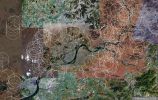
(click thumbnail to enlarge :up
If we look carefully at the distribution of air defenses we see two clear belts of AAA arranged concentrically, with the greatest concerntration on the South East side of the city:
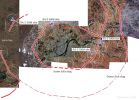
(click thumbnail)
One curiosity is the apparent gap in the outer AAA ring on the West side of the city. There is no clear explanation for that.
1.1 AAA positions dissected
The sites around Pyongyang are fixed, with approximately 75% occupied at any one time. We cannot easily identify which of the various AAA equipments relates to which sites, but there are certain characteristic layouts employed. The most common is a “rose” layout, with 4-8 AAA guns arranged in a circle with communication paths and trenches either around in a circle, or spidering out from the middle. A typical layout from South East Pongyang:

(click thumbnail)
Many of these sites will have a fire-control radar (FCR) although there is no indication that these have been upgraded beyond 1960s Soviet technology. The main AAA fire control radars reported are ‘Flap Lid’, ‘Fire Can’ and ‘Tilt Drum’. Although they can be jammed their advantage is that they are low powered and highly localized so stand-off jamming works less well.
The ‘rose’ pattern is designed to give 360 degree coverage, but it is giving way to linear (and thus mono-directional) emplacements, sometimes even built on a previously rose-pattern site:
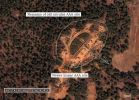
(click thumbnail)
1.2. AAA equipment
North Korea operates a variety of static AAA equipment but most of it is widely considered obsolete in modern warfare. The AAA can be loosely divided between Light, Medium and Heavy.
The cornerstone of North Korean AAA is the ZPU-2 and ZPU-4 series light AAA. Although it is difficult to get confirmation that this is still the case, the ZPU-4 14.5mm quad machine gun is likely to be the most prevalent system. Of Soviet origin, this is now produced in North Korea also.
In the right circumstances the ZPU-4 can be devastating, particularly to unarmored helicopters, but it is very short ranged (far shorter than the range of a Hellfire missile for example) and is much less effective against armored helicopters and fast jets.
Other prevalent AAA systems include M-1939 37mm AAA and S-60 57mm AAA. North Korean S-60 57mm AAA with ‘Fire Can’ radar:
etc..........
Here is a second overview of the DPRK's SAM network drawn from open source written by a professor who is a Janes IHS contributor.
The North Korean SAM Network
INTRODUCTION
The Democratic People's Republic of Korea fields one of the most capable third-world strategic SAM networks on paper. However, despite the high concentration of strategic SAM batteries and EW sites, there are significant issues in the network which need to be addressed in the near future. If these issues are ignored, the DPRK will be placing itself at risk.
THE STRATEGIC SAM FORCE
The DPRK's strategic SAM assets are subordinate to the Air Force. The Air Force operates a variety of Soviet-era equipment. The following strategic SAM systems are currently in service: S-75 (SA-2 GUIDELINE), S-125 (SA-3 GOA), and S-200 (SA-5 GAMMON)...
SAM Coverage
There are currently fifty eight active strategic SAM sites located in the DPRK. The following image depicts the locations of these sites. S-75 sites are red, S-125 sites are light blue, and S-200 sites are purple. As can be seen, the overwhelming majority of the deployed strategic SAM assets are located along the DMZ and the coasts.
CONCLUSION
...The DPRK is the new Iraq. During the lead-up to Operation DESERT STORM, the Iraqi air defense network was often described as being one of the world's most capable. This turned out to be an erroneous description, based in part due to Iraq's overreliance on dated technology and weapon systems. The same problems which plagued Iraq's air defense network in 1991 are evident in North Korea's current network, and must be rectified if the DPRK intends to field any sort of credible air defense in the 21st Century.
I would point out that while formidable in appearance, the DPRK integrated air defense network is similar to pre 1991 Iraqi or 1972 Hanoi air defenses in both form and structure employing a modified Soviet doctrine.
The coalition air forces in '91 and the USAF in 1972 both achieved total air superiority within 72 hours.
Reading some of the comments, its clear that quite a few people don't understand or appreciate the overwhelming superiority of a combined U.S./ROK maximum effort strike.
Contrary to the silly derogatory comments about the U.S. failure to counter goat herders in Afghanistan, this is the type of battle that the U.S. military excels in executing.
Here is how it goes....
Before a shot is fired various electronic countermeasures blind the long range search radars and disrupt communications hindering any attempt to coordinate tracking.
A large simultaneous wave of unmanned Air Launched Cruise Missiles, Tomahawks and various reusable drone systems mixed with decoys target command and control, ballistic missile and radar sites, runways etc begin to blind and paralyze the enemy's ability to maintain situational awareness and respond in a coordinated manner.
B-2's and Predator C drones roam with impunity individually targeting the priority leftover's such as mobile SRBM transporter/erector/launchers and SAM sites while F-22 suppress any attempt to scramble manned fighters which opens the sky at high altitude for conventional, non stealth aircraft.
PAC-3, THAAD and Aegis BMD provide a theater wide umbrella blunting the inevitable SRBM/IRBM counterstrike
F-15C's and K's establish a MIGCAP while the F-15E's, F-18's, F-16's continue the suppression of enemy air defenses while B-1's and B-52's go to work attriting the hardened targets and pertinent ground forces.
HARM's and JDAM's aside, munitions like the CBU-97 will make short work of the soft skinned Shilka ZSU's.
Anyone not familiar with what a CBU-97 is capable of in terms of decimating entire mechanized battalions with a single weapon should watch this
Developed and produced by Textron Defense Systems, the CBU-97 Sensor Fuzed Weapon is a United States Air Force 1,000-pound-class (450 kg) non-guided (freefall) cluster bomb, hence the name CBU (Cluster Bomb Unit).
The CBU-97 consists of an SUU-66/B tactical munition dispenser that contains 10 BLU-108 submunitions. Each submunition contains four hockey-puck-shaped sensor-fused projectiles called Skeets. These detect targets, such as tanks, armored personnel carriers, trucks and other support vehicles, and fire an explosively formed penetrator.
Once the small caliber, low altitude AAA umbrella has been sufficiently compromised the A-10's and AH-64's begin the task of destroying the remaining DPRK artillery threat within range of the DMZ and if the scope of the ROK/U.S. mission includes ground forces anything else that moves on the battlefield.
If a substantial ground deployment were in the cards, such as forcing regime change, it would be in the midst of the chaos that the M1's and K1's would cross the border.
In short, if a shooting breaks out the ROK will undoubtedly suffer greatly however barring PRC intervention ( a la the Chosin reservoir in December of 1950 ) it is a hopeless situation for the DPRK.
The unknown is the potential in the thousands of DPRK special forces operators to wreak havoc throughout the south although ROK intelligence and security forces aren't exactly slouches.
Anyhow, food for thought.
edit on 29-3-2013 by Drunkenparrot because: added content
Originally posted by nidstav
But, could it be that it also signifies that the B2-planes are being phased out?
No.
U.S. Air Force Extends Service Life of B-2 Bombers
The U.S Air Force plans to extend the service life of the nuclear-capable B-2 bomber to nearly 2060, Aviation Week & Space Technology reported this week (see GSN, Aug. 18).
The bomber was once set to be retired in 2037, but the Air Force has pushed that back to 2058, said Harry Heimple, Northrop Grumman Integrated Systems’ manger for government requirements. In the meantime, several upgrades are planned for the B-2, including the addition of active stealth technology and the use of new materials to make the bomber more serviceable, Aviation Week reported (Wall/Fulghum, Aviation Week & Space Technology, Sept. 27).
Meanwhile, a new study by the Center for Strategic and Budgetary Assessment nonprofit research institute says that improvements to the Air Force’s fleet of 21 B-2 bombers would help maintain U.S. long-range strike capabilities, according to Defense Daily.
“Near-term improvements to current American long-range strike capabilities should emphasize on ‘precision information’ needed for precision strike,” the study says. “In the case of the bomber fleet, the next step with the greatest payoff would be to invest around $2 billion to modernize the avionics in the 21 B-2s” (Lorenzo Cortes, Defense Daily, Sept. 29).
The Air Force is also considering deploying a new long-range strike aircraft between 2020 and 2025, and perhaps as early as 2015, according to Aviation Week & Space Technology (see GSN, June 24). The new manned aircraft would be expected to have a range of 2,500 nautical miles, a speed of Mach 2 and a daytime attack capability (Wall/Fulghum, Aviation Week & Space Technology).
My twitter feed has just had this:
N. Korea says it enters 'war' against S. Korea SEOUL, March 29 (Yonhap) -- North Korea announced Saturday that it has entered a state of war against South Korea. In a special statement, the North said it will deal with every inter-Korean issue in a wartime manner.
And reality. RT @sunnyright: BREAKING: North Korea announces it is at war with South Korea english.yonhapnews.co.kr... …
edit on 29-3-2013 by rigel4 because: (no reason given)
reply to post by Drunkenparrot
My problem with open source material is it makes it really easy to underestimate an opponent. I don't think their defenses will be nearly as easy to eliminate as Iraq was. North Korea has been preparing with cave enhancements, and tunnels. They aren't going to be as easy ass other fights have been.
My problem with open source material is it makes it really easy to underestimate an opponent. I don't think their defenses will be nearly as easy to eliminate as Iraq was. North Korea has been preparing with cave enhancements, and tunnels. They aren't going to be as easy ass other fights have been.
Originally posted by Zaphod58
reply to post by Drunkenparrot
My problem with open source material is it makes it really easy to underestimate an opponent. I don't think their defenses will be nearly as easy to eliminate as Iraq was. North Korea has been preparing with cave enhancements, and tunnels. They aren't going to be as easy ass other fights have been.
I agree but its the one of the best we regular folks have to base our opinions from or that the few who may have some special insight can talk about on a public forum.
Personally, I think the current round of bellicose DPRK nonsense is internally rooted and has more to do with a 30 year old "kid" dictator solidifying his power base over the deeply entrenched old guard of the military by showing that he has the power and will use it.
I'm sure you have heard the rumors of a large purge of the top military ranks shortly after Kim Jong Il's death.
As far as the difficulty of a strike and how painful a cost would be paid to bring the North to "heel" or at least rendered offensively impotent is a good question.
Remember all the talk pre Desert Storm, Iraq was the 4th largest military with Baghdad boasting one of the worlds most formidable air defense networks (second only to the Soviet Moscow ADZ ) , mass coalition casualties etc. etc. .
You know how the story ended better than most...
I believe the threat is in how much damage South Korean civilian infrastructure, specifically Seoul, will have to absorb before the DPRK long range artillery ( missiles and guns) can be neutralized or is expended. I don't believe anyone is underestimating their potential but the U.S. and the ROK hold at least 2 generations of technological superiority and have the numerical hardware advantage.
Of equal importance, the U.S. has been fighting in some form or another for nearly 20 years now and have a well blooded combat force.
To be honest I believe that if the situation continues to escalate the PRC will end up reigning in the DPRK well before the Korean peninsula explodes.
The world is changing and in our modern age of global commerce, diplomacy and economics have hopefully trumped the "big stick" approach favored by many of our fore fathers.
edit on 29-3-2013 by Drunkenparrot because: (no reason given)
reply to post by Drunkenparrot
In Iraq though, you had a force that was for all intents and purposes in the open at all times. With North Korea, you're looking at caves, tunnels, and mountainous terrain. Yes the US will eventually hand them their heads, and has trained for this, but it's gonna hurt.
In Iraq though, you had a force that was for all intents and purposes in the open at all times. With North Korea, you're looking at caves, tunnels, and mountainous terrain. Yes the US will eventually hand them their heads, and has trained for this, but it's gonna hurt.
new topics
-
2024 Pigeon Forge Rod Run - On the Strip (Video made for you)
Automotive Discussion: 36 minutes ago -
Gaza Terrorists Attack US Humanitarian Pier During Construction
Middle East Issues: 1 hours ago -
The functionality of boldening and italics is clunky and no post char limit warning?
ATS Freshman's Forum: 2 hours ago -
Meadows, Giuliani Among 11 Indicted in Arizona in Latest 2020 Election Subversion Case
Mainstream News: 2 hours ago -
Massachusetts Drag Queen Leads Young Kids in Free Palestine Chant
Social Issues and Civil Unrest: 2 hours ago -
Weinstein's conviction overturned
Mainstream News: 4 hours ago -
Supreme Court Oral Arguments 4.25.2024 - Are PRESIDENTS IMMUNE From Later Being Prosecuted.
Above Politics: 5 hours ago -
Krystalnacht on today's most elite Universities?
Social Issues and Civil Unrest: 5 hours ago -
Chris Christie Wishes Death Upon Trump and Ramaswamy
Politicians & People: 6 hours ago -
University of Texas Instantly Shuts Down Anti Israel Protests
Education and Media: 8 hours ago
top topics
-
Krystalnacht on today's most elite Universities?
Social Issues and Civil Unrest: 5 hours ago, 8 flags -
Weinstein's conviction overturned
Mainstream News: 4 hours ago, 6 flags -
University of Texas Instantly Shuts Down Anti Israel Protests
Education and Media: 8 hours ago, 5 flags -
Supreme Court Oral Arguments 4.25.2024 - Are PRESIDENTS IMMUNE From Later Being Prosecuted.
Above Politics: 5 hours ago, 5 flags -
Massachusetts Drag Queen Leads Young Kids in Free Palestine Chant
Social Issues and Civil Unrest: 2 hours ago, 4 flags -
Meadows, Giuliani Among 11 Indicted in Arizona in Latest 2020 Election Subversion Case
Mainstream News: 2 hours ago, 4 flags -
Any one suspicious of fever promotions events, major investor Goldman Sachs card only.
The Gray Area: 10 hours ago, 2 flags -
Chris Christie Wishes Death Upon Trump and Ramaswamy
Politicians & People: 6 hours ago, 2 flags -
Gaza Terrorists Attack US Humanitarian Pier During Construction
Middle East Issues: 1 hours ago, 2 flags -
God's Righteousness is Greater than Our Wrath
Religion, Faith, And Theology: 15 hours ago, 1 flags
active topics
-
Candidate TRUMP Now Has Crazy Judge JUAN MERCHAN After Him - The Stormy Daniels Hush-Money Case.
Political Conspiracies • 776 • : Vermilion -
Gaza Terrorists Attack US Humanitarian Pier During Construction
Middle East Issues • 15 • : Irishhaf -
Massachusetts Drag Queen Leads Young Kids in Free Palestine Chant
Social Issues and Civil Unrest • 9 • : theatreboy -
Meadows, Giuliani Among 11 Indicted in Arizona in Latest 2020 Election Subversion Case
Mainstream News • 5 • : Disgusted123 -
God's Righteousness is Greater than Our Wrath
Religion, Faith, And Theology • 29 • : Topcraft -
2024 Pigeon Forge Rod Run - On the Strip (Video made for you)
Automotive Discussion • 4 • : TheInvisibleRedneck -
Chris Christie Wishes Death Upon Trump and Ramaswamy
Politicians & People • 18 • : FlyersFan -
Breaking Baltimore, ship brings down bridge, mass casualties
Other Current Events • 488 • : xuenchen -
Krystalnacht on today's most elite Universities?
Social Issues and Civil Unrest • 3 • : StudioNada -
University of Texas Instantly Shuts Down Anti Israel Protests
Education and Media • 178 • : theatreboy

